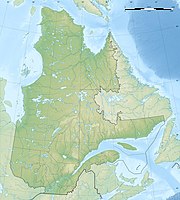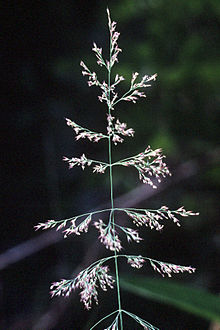Ecological Réserve des Tourbières-de-Lanoraie
|
Ecological Réserve des Tourbières-de-Lanoraie
|
||
| location | D'Autray , Quebec, Canada | |
| surface | 4.15 km² | |
| WDPA ID | 66622 | |
| Geographical location | 46 ° 0 ′ N , 73 ° 18 ′ W | |
|
|
||
| Setup date | 1994 | |
| administration | MDDEP | |
The Réserve écologique des Tourbières-de-Lanoraie is a 414.84 hectare protected area established in 1994 in the south of the Canadian province of Québec , in the county of D'Autray in the administrative region of Lanaudière .
Located 10 km southwest of Joliette , halfway between Saint-Thomas and Lanoraie , it is one of the few écologiques reserves that are open to the public. It is accessible from the beginning of June to mid-September via wooden walkways.
On the rocky bottom of the Utica Group ( Utica Shale ) from the middle Ordovician lies the clay slate left behind by the Champlain Sea and which only allows small amounts of water to pass through. The moors consist of fens and bogs , so mineral-rich and mineral-poor soils.
The Lanorais Bog Protected Area primarily represents the flora and fauna that characterize the region's bogs. In the more nutrient-rich fen, the dwarf birch thrives just like Carex oligosperma from the genus of the sedges , Ilex mucronata , known in the Anglophone world as Mountain Holly or Catberry , the mélézin à aulne rugueux or tamarack-speckled alder ( Alnus incana [L.] Moench . ), the pessière noire à némopanthe mucroné or black spruce-mountain holly , i.e. black spruce in combination with the mélézin à kalmia à feuilles étroites or tamarack-sheep laurel , the bétulaie grise à érable rouge or gray birch-red maple , then aulnaie rugle à saules or speckled alder with willows and Typha latifolia . The heather plants (Ericaceae) tend to be found in the less nutrient-poor Bogs .
The fauna is characterized on the one hand by mammals such as elk and white-tailed deer , beaver and muskrat , snowshoe hare , but also by 140 bird species, 90 of which are stationary. Among them are Red-shouldered Hawk , Eastern Towhee and sedge wren coined. There are also two species of fish, namely the American dogfish and the North American speckled stickleback ( Culaea inconstans ). Otherwise, the animal and plant species have so far been poorly documented.
As part of a teaching program led by the Société de Protection des Terres Humides , visitors can be guided through the protected area.
Web links
- Réserve écologique des Tourbières-de-Lanoraie , government website
- Une zone tampon pour la réserve écologique des Tourbières-de-Lanoraie , Plan d'action Saint-Laurent
Remarks
- ↑ Stickleback ( English, French ) In: The Canadian Encyclopedia . Retrieved August 21, 2016.

